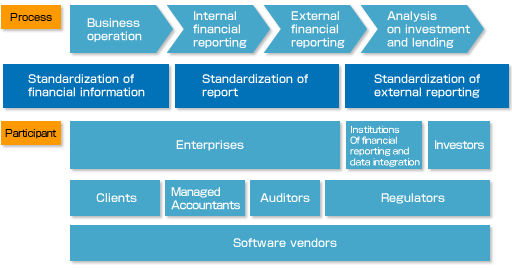Information of event
What is XBRL?
XBRL (eXtensible Business Reporting Language) is an XML-based computer language which is standardized for creating, distributing, and utilizing the information for several styles of business reports such as financial, management, and investigation. It is especially suitable to describe financial and disclosed information (ex. financial statements, internal reporting, etc.) of organizations.
Financial information, for example, is characterized as having different document structures, items, and formulas, depending on the year, organization, and industry. Therefore, the conventional way of creating financial information not only leads to high costs, but also makes standardizing and reusing it difficult. XBRL enables you to create and distribute/reuse electrically business reports easily with no regard to software and platform. As a result, all of the participants related to the supply chain of financial information such as companies, accountants, regulators, analysts, investors, participants in the capital market, software vendors, information and vendors, can reduce the cost to deal with the financial information and process the information with more accuracy and speed. Especially for the financial information published on the Internet, not only improving accuracy of data but also enabling reuse of data in other computer systems easier enhances the value of the information dramatically.
The "standardization" is the key word that realizes these benefits. XBRL international is a not-for-profit worldwide consortium which plays a main role in the area of promoting and supporting its adoption. The members of this consortium consist of different companies and agencies related to the financial information supply chain such as IASB (International Accounting Standards Board) that decides on IFRS (International Financial Reporting Standards), and are strongly promoting worldwide standardization and global promotion of XBRL. The countries adapting IFRS as their own accounting standard are increasing rapidly, but XBRL is the only technology in the world which enables creating, distributing, and reusing the financial information centered on financial statements, and that is why all of the world take more interest in XBRL .
Information Supply Chain
It is a common metaphor comparing the human body’s “blood” performing the financial function of continuously providing nutrition and oxygen to each body organ.
Then, what is the role of the "blood" in the financial industry? As the financial industry intermediate money, it can be defined that the role of the "blood" in the financial industry is transferring "information" related to money. To take a closer look at the information about the money, it can be divided into (1) the information associated with trading the money (financial transaction information) and (2) the information associated with owners and users (lenders and borrowers) of the money (the information required for the decision-making of the financial information, risk management information, etc.).
It's not an exaggeration to say that the history of the financial industry is about controlling and managing these 2 main types of information efficiently. At first, managing information has started with (1) financial transaction information. In this phase, the purpose is to have both owner and user of the money connected effectively by computerizing process through on-line business, enabling a mass of transaction processed efficiently. In these days, STP (Straight Through Processing), which processes financial transactions from a starting point to a settlement uniformly, has become more important for managing risks of the financial institutions. Especially in direct finance, as the degree of depending on outsource is high that STP is recognized as the main business obstacle.
While introducing the concept of STP and realizing its efficiency in the financial transaction area, bringing efficiency to the information stated above as (2) such as financial information and risk management information required for decision making has become another obstacle to achieve. As the spread of the Internet had social change speed faster than ever, people realized that decision making process speed reached it's limit to bring efficiency to it only with existing paper-based information. We think it would be more convenient to define a standard data exchanging protocol used for exchanging information from systems to systems for decision making than connect the systems with static way to exchange information, because a decision making is not the static business process and needs flexible analysis methods for each ad hoc purpose collecting various kinds of data.
This is the reason why "XBRL" received great publicity as an efficient management method of "financial information" required for decision making.

The financial data defined in "XBRL" standards is entered into a computer by a submitting company. Then computers start to communicate each other based on applications of financial information and the information runs through all over the functions forming the financial industry, like "blood".
As there is no process to reenter the data in supply chain, the arrival time of data from suppliers to recipients is short and the data arrives each related systems instantly without being altered. In addition, this data is downloaded directly towards the analytical process.
It seems, as if the artery carrying "blood" delivers nutrition and oxygen to each of the organs, that the financial information brings the data to each of the financial services. Furthermore, this financial data will be used and altered as needed basis for creating reports, managing risks, disclosing information, a tax return, etc. This is a whole image of the supply chain using XBRL.
![]()